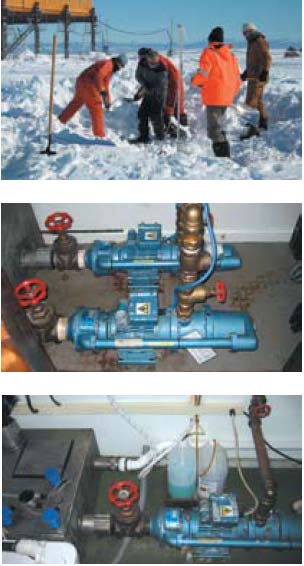Plumbing in the Antarctic

“Everything revolves around the relief ships and logistics. Whatever is taken onto this frozen continent must be removed, so the less one needs for effective operation the more time and resources can be dedicated to research rather than survival.
“That was our starting point for this project – use less, be efficient and engineer reliability into all the systems.
“First, reduce water consumption to a minimum by using, for example, spray taps, water-efficient appliances and vacuum toilets. There are washing machines that use the final rinse water from the previous wash as the first fill for the next wash.
“Another target is a ‘low water use’ regime by residents of Halley VI. Everyone on the base is educated to restrict their water use. Daily showers are commonplace, but there is a direction to keep them short.
“Having reduced daily water use to about 50L (13 gallons) per person, it became difficult to justify recycling wastewater. It was a maintenance problem we didn’t want, and the benefits were very small.
“However, we did process human waste by bio-digestion, followed by dewatering by centrifuge and incineration. It reduced the necessity to discharge anything other than ‘clean’ wastewater into the ice.
“The choice of vacuum drainage provided many advantages – water use is very low, the modular configuration of the base allowed repetitive use of any parts, and the linear arrangement of the modules worked best with a non-gravity system.”
The water and waste schematic (Fig. 1) shows the path from potable water generation to waste removal.
Two buried melt tanks are an integral part of the base. These large containers have hot water coils to melt the ice and snow that they are filled with every day. The water is pumped up to one of the two energy modules, where it is filtered and purified to potable standards. It is then stored in a conventional cold-water storage tank and pumped to various appliances and outlets on demand.
The vacuum drainage system returns wastewater to the bio-digester and ‘clear’ wastewater is discharged into the ice. The sludge is dewatered and burned in the on-site incinerator. Any residue is shipped off the site at the end of the summer season.
‘’We plan to provide a reliable and flexible ‘state of the art’ facility with a low environmental footprint to match our client’s science, comfort and cost criteria,” Maslin says.
“We are working hard to eliminate complexity, make the services easy to maintain and engineer a building that will be recognized worldwide as a new-generation research station in Antarctica.”
